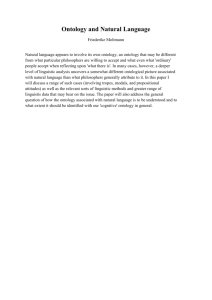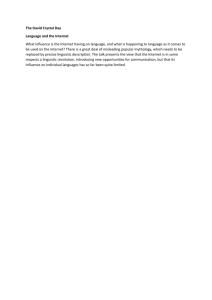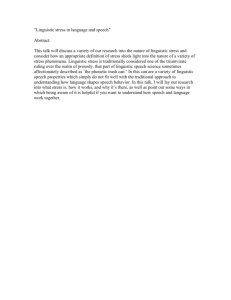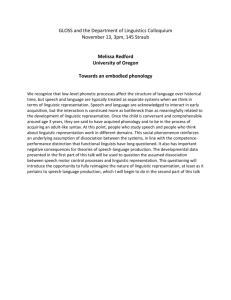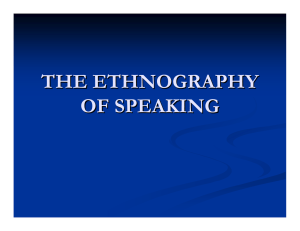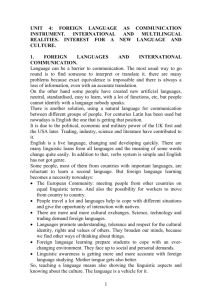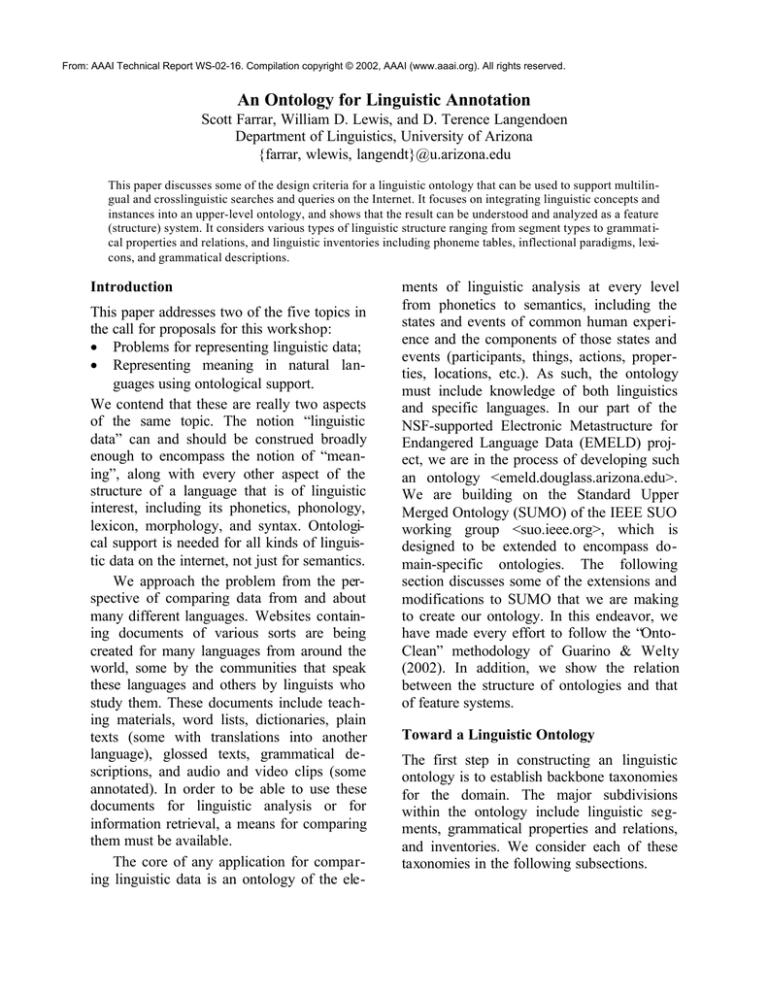
From: AAAI Technical Report WS-02-16. Compilation copyright © 2002, AAAI (www.aaai.org). All rights reserved.
An Ontology for Linguistic Annotation
Scott Farrar, William D. Lewis, and D. Terence Langendoen
Department of Linguistics, University of Arizona
{farrar, wlewis, langendt}@u.arizona.edu
This paper discusses some of the design criteria for a linguistic ontology that can be used to support multilingual and crosslinguistic searches and queries on the Internet. It focuses on integrating linguistic concepts and
instances into an upper-level ontology, and shows that the result can be understood and analyzed as a feature
(structure) system. It considers various types of linguistic structure ranging from segment types to grammatical properties and relations, and linguistic inventories including phoneme tables, inflectional paradigms, lexicons, and grammatical descriptions.
Introduction
This paper addresses two of the five topics in
the call for proposals for this workshop:
• Problems for representing linguistic data;
• Representing meaning in natural languages using ontological support.
We contend that these are really two aspects
of the same topic. The notion “linguistic
data” can and should be construed broadly
enough to encompass the notion of “meaning”, along with every other aspect of the
structure of a language that is of linguistic
interest, including its phonetics, phonology,
lexicon, morphology, and syntax. Ontological support is needed for all kinds of linguistic data on the internet, not just for semantics.
We approach the problem from the perspective of comparing data from and about
many different languages. Websites containing documents of various sorts are being
created for many languages from around the
world, some by the communities that speak
these languages and others by linguists who
study them. These documents include teaching materials, word lists, dictionaries, plain
texts (some with translations into another
language), glossed texts, grammatical descriptions, and audio and video clips (some
annotated). In order to be able to use these
documents for linguistic analysis or for
information retrieval, a means for comparing
them must be available.
The core of any application for comparing linguistic data is an ontology of the ele-
ments of linguistic analysis at every level
from phonetics to semantics, including the
states and events of common human experience and the components of those states and
events (participants, things, actions, properties, locations, etc.). As such, the ontology
must include knowledge of both linguistics
and specific languages. In our part of the
NSF-supported Electronic Metastructure for
Endangered Language Data (EMELD) project, we are in the process of developing such
an ontology <emeld.douglass.arizona.edu>.
We are building on the Standard Upper
Merged Ontology (SUMO) of the IEEE SUO
working group <suo.ieee.org>, which is
designed to be extended to encompass domain-specific ontologies. The following
section discusses some of the extensions and
modifications to SUMO that we are making
to create our ontology. In this endeavor, we
have made every effort to follow the “OntoClean” methodology of Guarino & Welty
(2002). In addition, we show the relation
between the structure of ontologies and that
of feature systems.
Toward a Linguistic Ontology
The first step in constructing an linguistic
ontology is to establish backbone taxonomies
for the domain. The major subdivisions
within the ontology include linguistic segments, grammatical properties and relations,
and inventories. We consider each of these
taxonomies in the following subsections.
Linguistic Segments
SUMO already contains basic segmental
notions such as Word, Phrase and Sentence
subsumed under the concept LinguisticExpression. However, we are making significant revisions to this section; some of our
preliminary results are shown in Figure 1.
LinguisticExpression
Morpheme
BoundMorpheme
Root
Affix
Prefix
Suffix
FreeMorpheme
WordPart
Stem
Word
FunctionWord
ContentWord
Phrase
Sentence
Text
Figure 1 Partial taxonomy of linguistic segments
The classes in Figure 1 are adequate to describe most segmental phenomena encountered in the domain of morphosyntax, which
is where we are starting our work. For exa mple consider the snippet of Warumungu
glossed text in Figure 2 (from Simpson 1998:
727, example 19). From the conventions of
text glossing (which can be represented in
various ways in a markup language) and
rudimentary knowledge of Warumungu
grammar, we can infer that purrumu is an
instance of Root and rra of Suffix (and from
the ontology, also of BoundMorpheme,
Morpheme, and LinguisticExpression). In
addition, purrumurra as a whole is an instance of ContentWord (and hence also of
Word) and of Sentence.
Purrumu-rra!
touch-IMPER
‘Touch it!’
Figure 2 Simple Warumungu glossed text
Of course there is much more to the analysis
of these segments than identifying their
segment type. For example they are segments
in the Warumungu language, not in Sanskrit
or C#. We can use an ontology to express
these facts as well. Language is a category in
SUMO, and Warumungu can be considered
an instance of that category. Moreover, the
strings purrumu and rra are written in an
orthography designed for that language, and
so can be considered instances of the category OrthographicString (or OString). This
category is a kind of SUMO Relation, since
it has two arguments, the first a string of
characters and the second the orthography in
which that string is written; it should also be
considered a kind of SymbolicString, a category already defined in SUMO. We propose
to add Orthography to the ontology defined
as a set of characters with a sort order defined over them, and other properties.
WarumunguOrthography (or WOrth) is an
instance of Orthography. Consequently the
instance of Root in Figure 2 is the structured
object representing the combination, by
mutual inheritance, of Language and OString
concepts and instances in Figure 3.
+-+
[Root | Language Warumungu
| ]
| OString <purrumu WOrth> |
+-+
Figure 3 Warumungu purrumu as a structured
instance of Root
The relation between ontological categories
and instances is essentially that of feature
(structure) systems (Shieber 1986; Lange ndoen & Simons 1995; Maxwell, Simons &
Hayashi 2002). A category and its instance
together is a feature, with the category being
a feature name and the instance a feature
value. An instance, or feature value, may be
unstructured, such as that of the category, or
feature names, Language; or a feature structure, such as that of Root. Unstructured
instances may be further typed, such as
boolean, integer, string, member of a closed
class of atoms (as in the case of instances of
Language), etc. The value may also be a list
of instances, as in the case of OString. Those
instances may themselves be unstructured or
feature structures.
Finally, we note that a property in SUMO
(one-place Predicate, called Attribute) is
represented as having a single instance, and
Relation in SUMO (a multi-place Predicate)
as having a list of two or more instances.
The Root feature in Figure 3 could in
principle be made part of the linguistic ontology, just like any other instantiation of an
ontological category. However, the most
appropriate place for its value to be stored is
as a lemma in a machine-readable dictionary
of Warumungu, together with a link to the
ontological category of which it is a value,
and links to its occurrences in Warumungu
texts and other documents.
The analysis of purrumurra as a Word
must take into account that it is composed of
the parts purrumu and rra, and so should
contain the features that represent those parts,
as in Figure 4 (with additional abbreviations
to make the figure fit the allotted space).
+| Lang
| OStr
|
| Root
[Word |
|
|
| Suff
|
|
+-
Warumungu
<purrumurru WO>
+-+
| Lg Warumungu
|
| OS <purrumu WO> |
+-+
+-+
| Lg Warumungu
|
| OS <rru WO>
|
+-+
-+
|
|
|
|
| ]
|
|
|
|
|
-+
Figure 4 Warumungu purrumurru as a structured
instance of Word
The structure in Figure 4 appears redundant,
since (in particular) the Language feature
appears in three different feature structure
components. The “percolation” of this fea-
ture can be expressed by a rule that in effect
specifies that the Language feature of a Word
is the unification of the Language feature of
its parts. The spelling of the word is also
predictable from the spelling of its parts
together with the fact that rru is a Suffix. 1
Grammatical Properties and Relations
We have already observed that SUMO distinguishes between properties, subsumed
under the category Attribute, and relations,
subsumed under Relation. Among the properties already identified in SUMO are ColorProperty and ShapeProperty, to which we
have added GrammaticalProperty. Among
the relations already identified in SUMO are
SpatialRelation and TemporalRelation, to
which we have added GrammaticalRelation.
From the information in Figure 2 and
knowledge of Warumungu grammar, we
conclude that purrumu is a verb root that
expresses the two-place Relation ‘touch’; we
leave open the question of what subclass of
Relation it is an instance of. The fact that a
Root that means ‘touch’ is a verb root is not
an accident; we would not expect a verb root
in any language to mean ‘kangaroo’. To
account for this, we propose first that Express is a GrammaticalRelation that holds
between a LinguisticExpression and its
meaning (in this case another two-place
Relation). Second, we define Meaning as a
GrammaticalProperty of any LinguisticExpression that is a first argument of Express;
the value of the Meaning feature being the
second argument in a true assertion of that
Relation. Third, we propose that GrammaticalCategory (henceforth Category) is another
1
Suffix is represented in Figure 4 as an Attribute, but
should really be considered a Relation, whose second
argument is the LinguisticExpression to which it is
suffixed. In this case, it is the Root purrumu, which
can be indicated by a “reentrant value”, a pointer to
the occurrence of that root in the Word feature.
GrammaticalProperty, and that one of its
instances is Verb. Finally, we propose that
any LinguisticExpression can have a Category feature, but that there are rules that
relate its other features, including what it
expresses, to the value of that feature.
We also conclude that rra is a Suffix that
expresses the three-place Relation ‘command’, in which the first argument is the
Speaker, the second argument is the Hearer,
and the third argument is a Proposition about
(in this case) the Predicate (Attribute or
Relation) expressed by the verb root to which
it attaches. This Predicate is further understood as holding of the Hearer. It is conve ntional to associate the feature [Mood Imperative] with such expressions, so that the
presence of this feature is a surrogate for the
Meaning of the expression containing it. 2
Mood is a subclass of GrammaticalProperty whose other instances include Declarative and Interrogative, and so represents a
range of GrammaticalRelations involving the
Speaker, the Hearer, and the Proposition
being expressed. The Mood feature also
“percolates” to the Word and Sentence containing the Morpheme with that feature, with
its argument variables instantiated. The
grammatical properties of the linguistic
expressions in Figure 2 appear in the SUMO
Attribute hierarchy fragment in Figure 5.
In general, a LinguisticExpression can be
viewed as a feature whose value is a feature
structure consisting at least of Language and
SymbolicString features, and some number
of GrammaticalProperty features as in Figure
6, which extends the analysis in Figure 3. For
practical reasons described below, we propose that grammatical relations appear only
2
The label IMPER that Simpson uses for this feature
value is significant only for the document itself. The
ontological category should be linked to the term that
the label stands for, not the label itself.
indirectly in such feature structures via their
GrammaticalProperty counterparts, for example the Express Relation appears via the
Meaning Attribute.
Attribute
GrammaticalProperty
Meaning
Category
Noun
Verb
Mood
Declarative
Imperative
Interrogative
Figure 5 Place of Category and Mood in the
SUMO Attribute hierarchy
+-+
| Language Warumungu
|
[Root | OString <purrumu WOrth> | ]
| Meaning ‘touch’
|
| Category Verb
|
+-+
Figure 6 Further analysis of Warumungu purrumu as a structured instance of Root
Our proposal that grammatical relations be
represented indirectly as grammatical properties is meant to apply only to the representation of expressions in glossed texts, lexicons and the like, not for feature-structurebased linguistic analyses generally, partic ularly those designed to parse or generate text,
rather than simply to represent it. We have no
quarrel, for example, with HPSG analyses in
which the arguments of a multiplace predicate are represented as a list, so that the
relational character of that predicate is explicitly represented (Pollard & Sag 1994).
Our recommendation is simply that in the
web-based linguistic ontology, a means be
provided for coding grammatical relations as
attributes of the linguistic expressions that
enter into those relations. So for example, the
Warumungu sentence Purrumurra! ‘Touch
it!’ would have a Subject attribute (a feature)
whose value is a feature-structure representing the Hearer, and a Direct-object attribute
whose value is a feature structure representing an Object, whose reference may be determined in the larger text in which that
sentence appears.
Similarly, we propose that the three-place
AssignCase relation, involving a CaseAssigner (typically a verb or function word of
some sort, e.g. a preposition), a Case Assignee (typically a noun phrase bearing some
GrammaticalRelation to the verb or function
word), and a Case, be indirectly represented
by a set of GrammaticalProperty features on
the linguistic expressions for the CaseAssigner, the CaseAssignee and the Case. In
Warumungu, the verb root ngu ‘lie’ assigns
DativeCase to the NounPhrase that serves as
its Direct-object, as illustrated by the exa mple in Figure 7 (Simpson 1998: 727, example
22).
Yama+ajurnu jarti-ki+karn
leave+3PL.NS other-DAT+now
pikapikka-ka ngu-nngara.
children-DAT lie-OPT.FUT
'Some should be left for the
other children.'
Figure 7 Illustration of DativeCase assignment in
Warumungu
In this example, the suffixes ki and ka contain the feature [Case Dative], which is
inherited by the words jartikikarn and pikapikkaka containing them, and then by the
NounPhrase jartikikarn pikapikkaka. That
noun phrase in turn is represented as the
Direct-object of the verb root ngu. From this
representation, the fact that ngu assigns
DativeCase to its Direct-object does not
follow, but that fact could be represented
explicitly as a feature of ngu, say as [CaseOfDirectObject Dative]. By omitting certain features that contribute to the AssignCase relation, such as CaseOfDirectObject,
the individuals encoding the data do not have
to commit to any particular theory of case
relations in marking up their data for Case.
Such markup could be used either by those
individuals or other researchers to determine
what theory of case relations best accounts
for those data. 3
Finally, the association of particular
GrammaticalProperty features with particular
LinguisticExpression types may be determined by general or language-specific rules.
In Warumungu, for example, the feature
[Category Verb] is directly associated with
the Root type, whereas the feature [Category Noun] is directly associated with the
Word type.
Linguistic inventories
Linguists present much of their analysis of a
language in the form of tables and structured
lists of various sorts, for which we use the
cover term ‘inventory’. These provide a
handy form for expressing information about
a language in a compact form, and with
proper encoding provide a convenient source
for capturing a great deal of linguistic data.
In some cases, they also reveal conflicts in
the use of terms that must be resolved if
consistency and data integrity are to be
achieved.
We propose that several of the types of
inventories that linguists use be instantiated
as concepts in the linguistic ontology, among
them phoneme tables, inflectional paradigms,
and lexicons. By doing so, we hope to
achieve a degree of uniformity and consistency that is currently lacking in the linguistics literature, but without imposing an encoding standard that will simply be ignored
by the majority of data providers.
3
In the suggested encoding, the two-place grammatical relation AgreeInCase that presumably holds
between jartiki and pikapikkaka is also not represented.
Phoneme Tables
A very familiar datatype is the consonant
phoneme table, with the rows representing
manner of articulation (typically from least to
most sonorant), and the columns points of
articulation (from lips to glottis). The phoneme that appears in a particular cell has the
manner-of-articulation feature(s) of its row
and the point-of-articulation feature(s) of its
column. So for example from the fragment of
the Warumungu consonant phoneme table in
Figure 8, simplified from Simpson (1998:
710, Table 32.1), we learn that the WOrth
segment pp represents two distinct phonemes, one a long voiceless bilabial stop [p:],
and the other a short one [p].
stop
long vl
short vl
short vd
nasal
lateral
flap
semivowel
bilabial
alveolar
pp [p:]
pp [p]
p [b]
m
tt [t:]
tt [t:]
t [d]
n
l
rr [r]
...
w
Figure 8 Fragment of Warumungu phoneme table
Simpson’s table is an instance of the ontological subcategory ConsonantPhonemeTable, defined as providing manner- and
place-of-articulation information about the
consonant phonemes of a language in the
manner just described. The features that
appear in the row and column identifiers in
any instantiation of the table should also be
linked to the linguistic ontology.
Inflectional Paradigms
Perhaps even more familiar are inflectional
paradigm tables such as conjugations for
person and number of the subject in various
tenses and aspects of the Spanish verb as in
Kendris (1990), and declensions for case and
number in the various Latin noun classes. As
these examples illustrate, the category InflectionalParadigm is not defined by its features,
since these vary from paradigm to paradigm.
Rather, it is characterized by:
1. completeness: every instance of the combination of interacting features is instantiated;
2. multidimensionality: at least two features
are involved;
3. significance: the features play a major
role in the grammar of the language;
4. contrast: the linguistic expressions that
manifest the feature combinations (typ ically morphemes) contrast with each
other, typically in a given position within
a word.
The completeness criterion gives rise to the
concept of Suppletion, the occurrence of
phonologically distinct forms in parts of the
paradigm, for example voy ‘I go’, fui ‘I went’
and iba ‘I was going’ are all part of the same
paradigm of the Spanish verb ir ‘to go’. It
also accounts for the description of paradigmatic gaps as unexpected, as the absence of
an ‘away’ form of the L-conjugation class of
verb roots in the past continuative tense (sic)
in Warumungu (Simpson 1998: 722, Table
32.4). Similarly, incomplete paradigms are
sometimes described as “defective”.
The contrast criterion sometimes appears
to make strange bedfellows. For example, in
Warumungu, the following instances contrast
in the paradigm for motional verbs: future,
imperative, present, past punctual, past continuative, admonitive, and optative/irrealis
(Simpson 1998: 723, Table 32.5). These
appear to be instances of four different fe atures: Tense (past, present, future), Aspect
(punctual, continuative), Mode (optative/irrealis) and Mood (imperative and
admonitive). The solution in this case is to
identify the nearest common feature in the
ontology for Tense, Aspect, Mode and
Mood, so that the contrasting instances are
all instances of that common feature.
Lexicons
At minimum, a lexicon consists of a list of
expressions in a given language, and some
grammatical features associated with each,
usually including its meaning. In a monolingual lexicon the meanings are expressed as
paraphrases in the same language ; in a bilingual lexicon as a translation into another
language. Given an ontology of concepts that
provide a basis for the analysis of meaning of
expressions in human languages (see
Gangemi et al. 2001), we can envision lexicons in which each meaning is an instance of
a universally defined feature or bundle of
features, i.e. a feature structure, that can be
compared systematically with meanings of
other entries in the same lexicon, or in different lexicons, i.e. of different languages.
Moreover if indeed a grammar is simply
a means of projecting a lexicon onto a language as a whole (i.e. all of its expressions),
then access even to incomplete (but well
designed) lexicons for a variety of languages
on the Internet that are correctly linked to the
linguistic ontology we envision will be a
tremendous resource for both language comparison and multilingual information retrieval.
Two Goals for a Linguistic Ontology
Throughout this paper, we have made more
or less explicit certain concepts that may be
described as “grammatical” in the narrow
sense of that term, whose understanding
requires knowledge of delimited, but still
extensive, aspects of semantics as a whole.
We have however alluded to the possibility
that a linguistic ontology that deals with all
of linguistic semantics, including lexical
meaning in its full glory, can be constructed.
We now consider two research goals, which
can be worked on in parallel, though not
entirely independently of each other.
The first goal is to define each narrowsense grammatical concept and its possible
instances, such as DurativeAspect and InstrumentalCase; in effect to provide the
semantics of the closed-class vocabulary of
as many languages as we can get adequate
descriptions of. The second is to provide the
basis of the analysis of the open-class vocabulary of human languages along the lines
sketched out toward the end of the preceding
section. The reason that these goals are not
independent is that the distinction between
features for open and closed classes is not a
clear one in any one particular language, and
even less so when comparing different la nguages. For example, the features involved in
the analysis of the closed class of “handling
verbs” in Athapascan languages are very
much like those needed to describe openclass vocabulary items in other languages.
SUMO has certain properties that may
help us toward reaching the first goal. We
may suppose that the semantics of Tense and
Aspect features of human languages can be
formulated in terms of the attributes and
categories of temporal logic. Since SUMO
already implements the temporal logic of
Allen & Hayes (1985), including such notions as Before, During, TimeInterval, and
TimePoint, we can formulate within SUMO
some general definitions concerning Tense
instances, as in Figure 9 in SUO-KIF fo rmat.
(<=>
(present ?SENTENCE)
(and
(exists ?PROCESS Process)
(represents ?SENTENCE ?PROCESS)
(overlapsTemporally
(WhenFn ?SENTENCE)
(WhenFn ?PROCESS)))
Figure 9 A definition for PresentTense
This definition may be read as “A sentence is
present tense just in case there exists some
process such that the sentence represents that
process and some part of the process occurs
at the time of speech.”
If the terms and the logic of the ontology
are rich enough, the very subtle distinctions
that are found in the closed-class semantics
of human languages can be adequately expressed, as long as the descriptions we have
at hand are clear enough for us to understand
what they are. Suppose in the description of
two different languages, we find a bound
morpheme in each labeled “durative”, described as applying to a state or activity that
lasts for a relatively long time interval. Ho wever upon closer examination, we discover
that they actually mean different things: One
requires that the state or activity be continuous over the interval, and the other does not.
Clearly these are distinct instances of the
Aspect category.
Reaching the second goal requires constructing a very broad-coverage ontology that
is designed specifically to work with the full
range of human language data. The ontology
designed for the CYC Project (Lenat & Guha
1990) may be adaptable for this purpose. We
have chosen to work with SUMO, because
we think we understand it better, and because
it has taken into consideration some explicitly linguistic concepts in its design, some of
which we have already discussed. In addition, it includes a very comprehensive section covering the major verb classes proposed by Levin (1993).
Grammatical Descriptions
We conclude by returning to the concept of
linguistic inventory, and propose that a
grammatical description, consisting of a set
of assertions about the structure of a language, qualifies as an instance.
Suppose that all we know about Warumungu are the properties of the example in
Figure 2. A description of that knowledge
would consist of a set of assertions such as:
•
•
•
purrumu expresses ‘touch’.
rra is a suffix for imperative mood.
The third person singular object pronoun
is phonologically null.
• purrumurra expresses ‘touch it’.
On the other hand, someone who knows
Warumungu well might be prepared to make
much more general assertions such as the
following, from Simpson (1998):
• Warumungu has six vowels: the three
short vowels /i/, /a/, /u/, and their long
counterparts.
• Primary stress is assigned to the first
syllable of a word with two or more syllables.
• Warumungu has the following six classes
of morphemes: nominals, preverbs, verb
roots, bound pronouns, particles and suffixes.
• Warumungu words are formed by suffixation, reduplication, compounding,
and template (for pronouns).
• Warumungu verb roots inflect for four
forms of “associated motion”: motion or
direction toward the deictic center, motion or direction away from the deictic
center, “setting out”, and neutral.
The linguistic ontology, if properly constructed, should provide a metalanguage for
expressing these assertions, enabling them to
be compared with other grammatical descriptions of the same or of different la nguages. It would also support the ability to
reason about a language, in order, for exa mple, to determine whether a particular analysis of a particular example is consistent with
a given grammatical description. Like the
other linguistic inventories suggested here,
grammatical descriptions can be very useful
resources even if incomplete. They cannot
however be inconsistent, so care must be
exercised when merging two grammatical
descriptions for the same language.
References
Allen J F & Hayes P J (1985) A commonsense theory of time. Proceedings of
AAAI-85, 528-531.
Gangemi A, Guarino N, Masolo C & Oltramari A (2001) Understanding top-level
ontological distinctions. Proceedings of
IJCAI 2001 Workshop on Ontologies
and Information Sharing.
Guarino N & Welty C (2000) Ontological
analysis of taxonomic relations. Proceedings of ER-2000: The International
Conference on Conceptual Modeling.
Kendris C (1990) 501 Spanish Verbs, 3rd ed.
New York: Barron’s.
Langendoen D T & Simons G F (1995) A
rationale for the TEI recommendations
for feature-structure markup. Computers
and the Humanities 29, 191-209.
Lenat D & Guha R V (1990) Building Large
Knowledge-Based Systems: Representation and Inference in the CYC Project.
Reading, MA: Addison-Wesley.
Levin B (1993) English Verb Classes and
Alternations. Chicago: University of Chicago Press.
Maxwell M, Simons G F & Hayashi L
(2002) Resources for morphology learning and evaluation: A morphological
glossing assistant. Proceedings of International Workshop on Resources and
Tools for Field Linguistics, Las Palmas,
Spain.
Niles I & Pease A (2001) Toward a standard
upper ontology. Proceedings of the 2nd
International Conference on Formal
Ontology in Information Systems (FOIS2001).
Pease A & Niles I (2002) IEEE standard
upper ontology: A progress report.
Knowledge Engineering Review 17, Special Issue on Ontologies and Agents.
Pollard C & Sag I A (1994) Head-Driven
Phrase Structure Grammar. Chicago:
University of Chicago Press.
Shieber S M (1986) An Introduction to Unification-Based Approaches to Grammar.
Stanford, CA: CSLI.
Simpson J (1998) Warumungu (Australian
— Pama-Nyungan). The Handbook of
Morphology, Spencer A & Zwicky A M,
eds., 707-736. Oxford: Blackwell.

